My auntie Keiko is my “go to person” when it comes to special recipes such as Inari Sushi. Everytime we go back to Japan, we visit my favorite uncle and aunt in Ise city, Mie prefecture. This is her special recipe using a secret ingredient which makes this Inari Sushi especially rich in flavour and I am going to share the secret with you!
What is Inari Sushi
Inari sushi is a type of sushi with rice balls wrapped in ‘Aburaage’ deep-fried tofu pouches. Known as Inarizushi in Japan this sushi is a little different. “Inari” the name, is derived from the “Inari” Shrine. For an offering to the shinto god Inari, this sushi was used. Because the favourite food of the Shinto god’ messenger fox is said to be Aburaage.
Differences in Kanto and Kansai region
In the Kansai region where I come from, the shape of the tofu pocket is a triangle. On the other hand, deep-fried tofu pockets shape in Kanto are square or rectangle. My mother used to cut the deep fried tofu Aburaage in triangles. I found, however, that the rectangle is easier to put sushi rice balls into the tofu pocket.
What is “aburaage”?
Aburaage is a delicious deep-fried soy product. Thin deep-fried tofu is aburaage. Thick deep-fried tofu is Atsu-age. You can buy aburaage from any Asian grocery stores or Japanese grocery stores. I often use aburaage for making Miso soup and Kitsune Udon. You can freeze them and it will store in the freezer for a month. When making inari sushi, the Aburaage is simmered in sweet soy sauce. Then cooked until most of the liquid evaporates, because in this time the Aburaage absorbs the sweet soy sauce.
Simple Two main ingredients of Inari Sushi
Inari sushi is a typical simple but sophisticated flavoured Japanese dish. Because it is so simple and requires only two main ingredients; Sushi Rice and seasoned Aburaage, we need to prepare those two ingredients well. You will need to read my post on how to make perfect Sushi Rice. We can not compromise sushi rice quality, you need to make it perfect. For preparing tasty tofu pockets to wrap sushi rice balls, follow the tips that I learnt from my aunt Keiko.
When I go back to Japan to visit my family and relatives, I always visit my favourite Uncle and Aunt who live in Ise city, Mie Prefecture. I used to live there too which is famous for Ise shrine, Mikimoto pearl, Ise Udon, Akafuku-mochi etc. My aunt Keiko is a very good home cook. She taught me how to make great inari sushi. Her secret ingredient to make the Aburaage pouch so rich in flavour is “MISO paste”
Kakushi Aji
Kakushi aji is the secret flavour which enhances the entire flavour. For this recipe, Kakushi Aji is “MISO paste”. You will not notice the miso because it is not the dominant flavour but it enhances the fragrance and enriches the flavour as a whole.
3 tips from my aunt Keiko for making inari sushi
-
- Yunuki – yunuki is removing excess oil off the aburaage by pouring boiling hot water over it
- Add a tiny amount of Miso paste to enhance the flavour.
- Cook the aburaage until all the liquid has evaporated. Why? Because this concentrates the sweet soy sauce base. Also, in this time the aburaage absorbs the sauce which increases the intense flavour.
FAQ
Q: Can I add something to the sushi rice? Or top the rice with something?
A: Yes of course. I sometimes add roasted white sesame seeds into the sushi rice. Make the sushi rice and when you add sushi vinegar, also add sesame seeds. In Australia, you can buy upside down Inari sushi topped with mayo and crab meat or seaweed. Let your imagination run wild and be creative!
Q: I don’t have Miso, what can I substitute it with?
A: If you don’t have Miso, you can omit the secret ingredient or as one of the readers suggested in the comments below, if you have oyster sauce, you could try it too. Add only a tiny amount.
Q: Don’t we have to roll aburaage pockets with a chopstick or handle of a wooden spoon ro open up the pocket? How do we open the pocket?
A: You would think that the pocket open magically and easily accept rice ball rolling in. Because those pocket cooked long enough till all liquid absorbed and evaporated, it opens up without any extra steps.
Hope you enjoy making my aunt Keiko’s inari sushi recipe. We certainly did. We often cook dishes such as Onigiri rice balls, Gyoza together. My children and I enjoy making Inari sushi together. And If you liked the tips and instructions for Inari sushi, please rate it and leave a comment below.
Also, don’t forget to follow me on Youtube, Pinterest, Facebook , Twitter and Instagram . This way you keep up to date with all the latest happenings on Chopstick Chronicles. Don’t forget to Sign up for a weekly newsletter so never miss out authentic delicious Japanese recipes! Sign up form is on the right-hand sidebar.
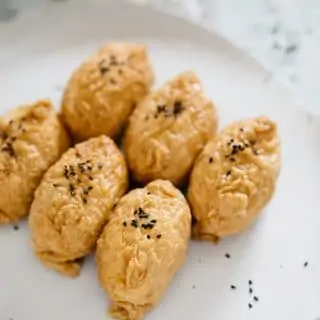
Aunt Keiko's Inarisushi
Equipment
- a sauce pan
Ingredients
- 600 g Sushi rice
- 6 abura age cut them in half and make 12
- 240 ml water
- 1 tsp dashi powder
- 30 g sugar
- 1/2 tsp miso paste
- 25 ml soy sauce
- 1/2 tbsp black sesame seeds to sprinkle
Instructions
- Cook and prepare the sushi rice (my sushi rice uses 2 cups of uncooked rice and I used about 2/3 of the entire cooked rice) *1
- Cut the aburaage pieces in half.
- Pour boiling hot water over the aburaage to remove the excess oil.
- Bring one cup of water in a saucepan to boil over high heat and add dashi powder.
- Add sugar, soy sauce to the saucepan.
- Turn the heat down to medium, add aburaage and cook for 10 minutes.
- Add miso paste and cook until all liquid has absorbed and evaporated.
- Turn the heat off and cool it down completely.
- Make 12 round and cylinder shape sushi rice balls (each weigh about 50 g)
- Open the aburaage pouch gently without breaking and insert one sushi rice ball and close the end side down.
- Repeat this same process for the rest of the 11 aburaage and rice balls.
- Serve on a plate and sprinkle black sesame seeds on top.
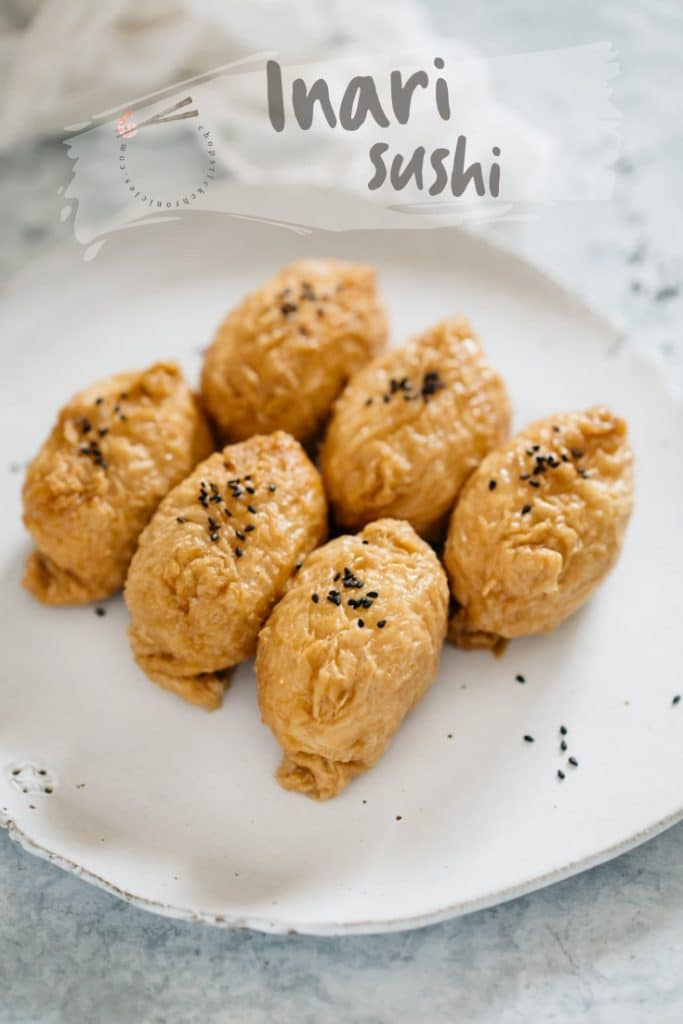

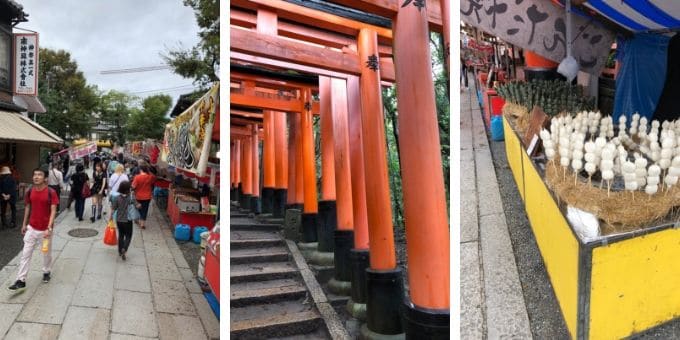
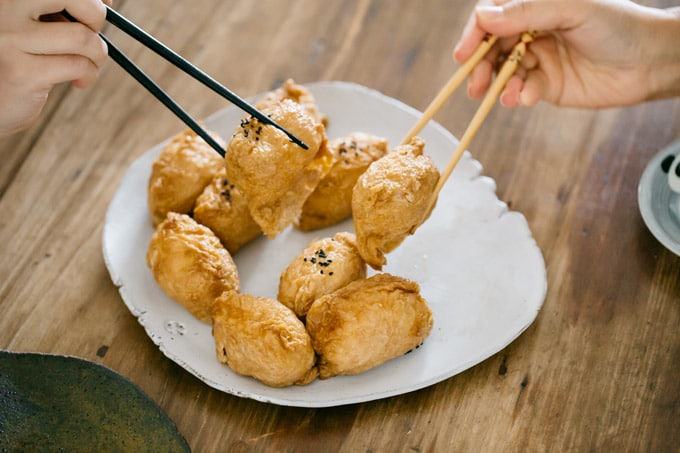
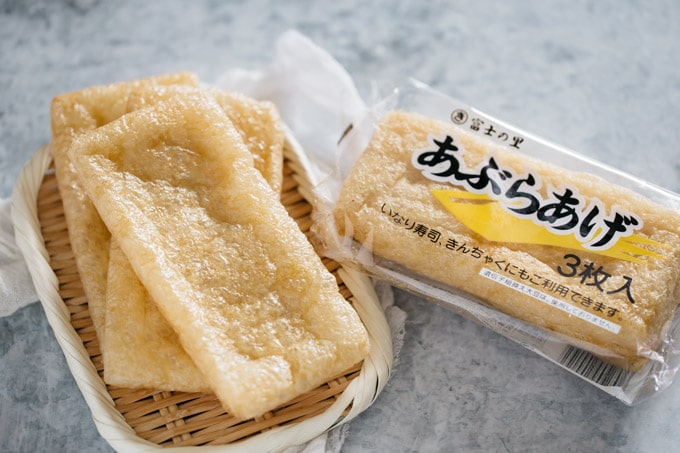
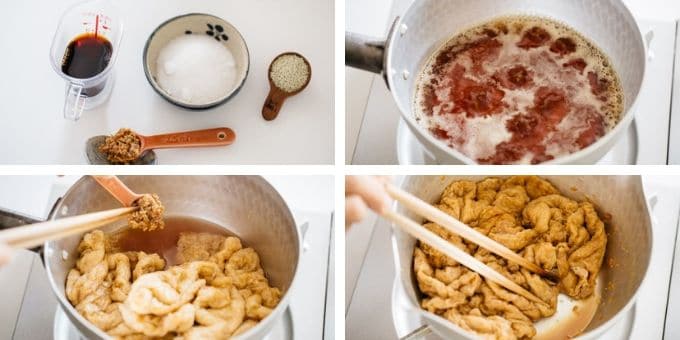
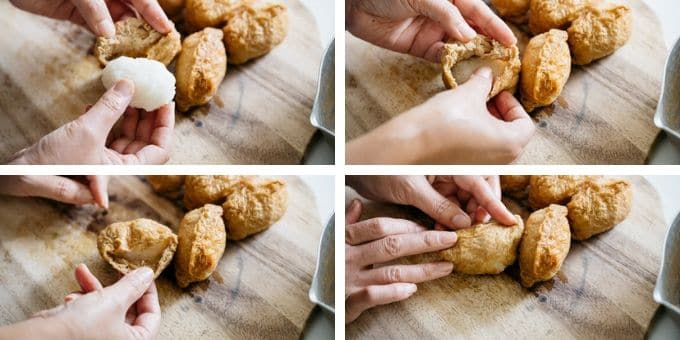
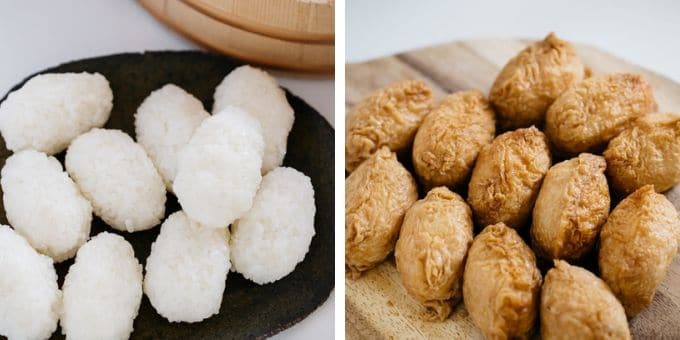
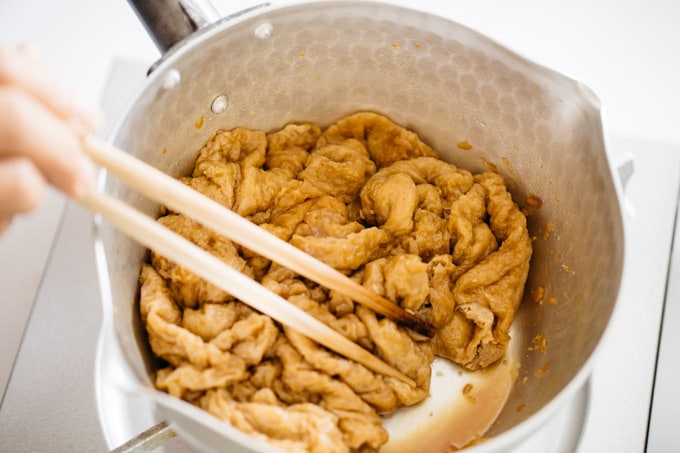
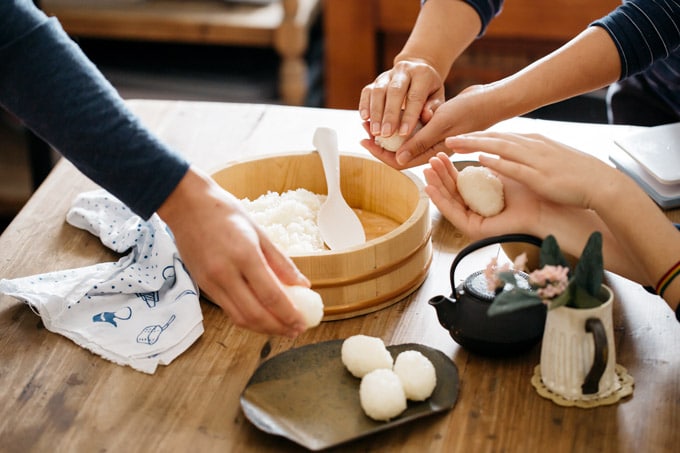
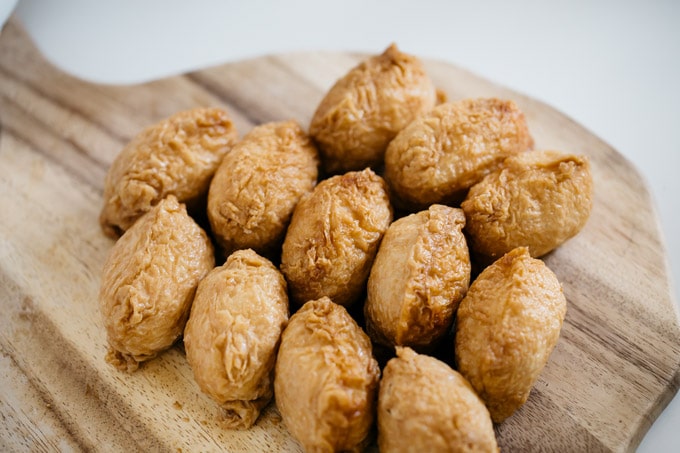
Love these! One of our favorites.
Thank you Pat 😀
Thank You for this great recipe and the 隠し味
You are welcome GrgeR 😀
Thank you for the beautiful photos and instructions. I enjoyed reading the recipe!
Hi Yichih, Thank you for reading the post 😀
Is it possible to use brown rice? or brown sticky rice?
Hi Brendan, yes you can use brown rice. Depends on the type of brown rice, sticky brown rice might be good choice, other brown rice could be too dry.
Seems like they might add a little sake for umami deliciousness but not really sure.
Hi Chidog, you can try but don’t really need sake to add for umami 😀
Inspiring Asian Cuisine Art.
Love it
Thank you Josephine 😀
My step-grandmother used to make inarizushi all the time, but she added sugar into the rice mixture – decades later, my mom still loves it extra sweet (but my older brother prefers it more like your recipe).
Her family was from Niigata – maybe the regional variation is sweeter up north?
Hi Tania yes there are many different version 😀
Konnichiwa, Your recipes are great! Thank you, but for people living in North America/ Canada, the measurements are extremely confusing. Please use cups, tsp, tbsp and or ml. ie: I dont have a kitchen scale to weigh 600 grams of rice, so I dont know how much that is. When looking online at conversion charts, well that can be confusing as well.
Hi Lenore, Thank you for your constructive feedback. I will be careful with the measurement. It does not have to be exactly 600g. It is about 6 cups of cooked rice.
Fyi- the nutrition label on the bag of rice (and most products) has the serving size in metric and American.
Hi Shihoko, I have recently discovered your beautiful blog and spent hours poring through the recipes and techniques. I am really looking forward to making this Inari for my boys! Thank you for all the delightful recipes x
Hi Sneh, Thank you so much. I have been following you on your instagram and learnt photography from you!!! 😀
Inari is one of my favourite sushi treats. In New Zealand, we sometimes get inarizushi with super finely chopped shittake and carrot mixed through the rice. Or sitting top open with fillings like sweet soy chicken, or chopped pork or chicken katsu.
Whereabouts in Australia would you recommend buying the Aburaage? I’ve only recently arrived here and haven’t found all the good shopping spots for special things like that.
Hi Grace. Yes there are many different variations of Inari exist in Australia 😀 I live in Brisbane and there are two Japanese grocery stores I know of and also many Asian grocery stores also stock Aburaage too. Please let me know if you want to know more specifically where about 😀
I have never tried inarisushi before! I’m definitely intrigued, it looks so perfectly prepared!
Hi Tisha Thank you, try Inari, you will like it 😀
I am so intrigued by this recipe. Is the Aburaage gluten free?
Hi Sandi, Aburaage is gluten free though, soy sauce to season aburaage is not. If you use gluten free soy sauce, you can make this gluten free 😀
I love it is really yum!
thank you! 😀
I wanted to make inarizushi for our New Years Eve get together. I decided to experiment with the cooking liquid, and added a tiny it of oyster sauce to it instead of the miso . It actually tasted pretty good, so I didn’t toss it. I hope everyone else at the gathering agrees. I’m also experimenting with a fancy presentation using shiso leaves, tobikko and nori. 30 grams of sugar is 1/4 cup for Americans.
Hi Kate, I am glad to know that you tried this recipe out and experiment different ingredients and glad that it turned out delicious 😀 And thank you for the measurement conversions. I am updating all recipes with new recipe card one by one, I will get to this recipe too eventually.Thank you again 😀
I love all your rexeipes. But it’s a bit puzzling to convert from your measurement to cups and teaspoons (US measurements).cant you also include cups and etc…..My mother-in-law also adds saki too. But no miso, have to try that. Hope to hear from you….
Love Inarizushi but I was taught additional fillings (red bean paste or others) with the rice. Also are you adding the sugar twice. The recipe says “add rice” twice????
Hi Lynne, Thank you for letting me know my mistyping. It supposed to add soy sauce not another sugar. Inarizushi does not have any other additional fillings, if Japanese do, it would be roasted sesame seed will be added to the rice. Definitely not red bean paste 😀
Thanks for the reply. The Sushi Chef I worked with used to make this with rice but also included red bean paste or sesame seeds. at times….so good! Also, he was from Kyoto!
Chef Lynne
I love inarizushi! It’s a nice coincidence that you posted this today because I bought fried tofu yesterday to make some haha
I’ve never tried with miso paste though, is it white miso paste?
My girlfriend adds a bit of diced tomato and fresh basil inside the pouch, it tastes so fresh and delicious 🙂